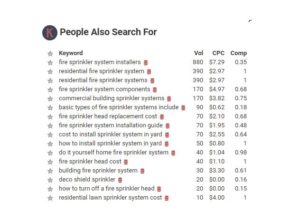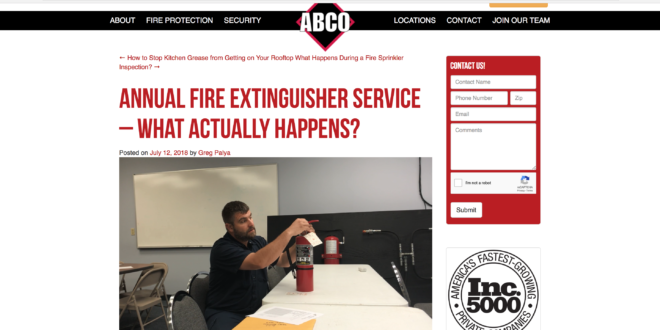Tips on How to Help Google Help You
One of the greatest ways to become a top search result on Google is to create online assets. Online assets come in the form of blog posts, eBooks, scorecards, quizzes, and videos. When you write informative blog posts, it’s important to keep your audience’s interests in mind. Your audience isn’t going to want self-promotional writing geared towards selling something.
Why Spend Time Creating Content?
When people begin the process of searching online for a solution, the first thing they do is visit Google. Relevance is a Google Ranking Factor. At a minimum, 75 percent of clicks happen on the first page. Thus, you need to be ranking high on Google.
The Million Dollar Question: What Is a Potential Buyer Going to Type into Google?
For example, suppose a potential buyer has an interest in purchasing a fire sprinkler system for their business. They would probably type into Google:
- What goes into a fire sprinkler system for a warehouse?
- How much does a fire sprinkler system cost?
- What is the minimum fire sprinkler system I need to be legal?
These three questions could all be answered through blog posts that any fire sprinkler company could write. This information will provide real value to potential customers.
If the reader trusts you (through your writing), they will continue to read your entire blog post, which is another Google Ranking Factor (bounce rate and time on page).
If someone is reading a blog post, then sees promotional content and “bounces” (hits the back button), this tells Google that the blog did not satisfy what that person searched for. Google will then decrease the ranking of that blog post.
On the flip side, if someone reads the entire blog post and spends a considerable time doing so (and possibly clicks forward to other pages on the same website), this gives Google an indication that the post satisfied what the searcher was looking for, and thus will increase its ranking on Google for similar searches.

Google search results.
How to Get Started
Here are three easiest ways to extract information that your buyers are most interested in:
1) Your Technicians Your technicians know the most about what solutions customers are looking to solve. However, getting a technician to write an entire article is difficult.
2) Shadowing If your technicians aren’t available to write, have an office staff member tag along on a few jobs. That person can ask questions, jot down notes, and extract all the information needed for a great blog post… all from an afternoon with a tech.
ADVICE: This is a great option because the “shadower” can take photos and/or videos at the job site to enhance the blog post’s text.
3) Technician Interview Interviews are a great way for a technician to really explain everything one needs to know to write a great blog post. The writer just needs to have a number of questions prepared.
ADVICE: Have the writer record the interview with his or her phone! It’s surprising how much can be miss by only jotting down key points. Plus, it gives the interviewer more time to pay attention to asking questions and diving deeper into questions that have more complicated answers.
What to Write About
Here are three tools that will help you collect great content ideas.
1) Hold a “think tank” session with your sales team to brainstorm which topics buyers are interested in. Questions to can ask the sales team are:
- Why do people buy from us?
- Where do people look for their information (email, Google, Facebook, industry magazines)
- Why do you believe people choose us over the competition?
2) Install “Keywords Everywhere,” a free Google Chrome extension that enables you to view analytics of Google search results. When you type something into Google, Keywords Everywhere will give you similar search results, volume (how many people are searching for a keyword), CPC (how much it costs to rank per click for a certain keyword), and competition (how likely it is to rank on page one for that keyword).
ADVICE: Choose to write about a keyword with a comp score less than .40. It might be hard to find, but keep searching different phrases until you find something. A keyword with a comp score of less than .40 will give you a great chance to rank on page one of Google. Of course other factors determine ranking, but a comp score of one will make it very, very hard to rank on page one.
3) Use OptinMonsters Educational Blog Post Topics OptinMonster is just one of many blog topic generators out there, but I love this resource because it’s more than writing a blog post, it’s writing an “educational” blog post. People come to learn about a topic, so writing something educational and helpful is going to satisfy the searcher.
Some of OptinMonsters’ ideas for writing a great “educational” blog post are:
- Can you walk your audience through a process, step-by-step?
- What are some of the common questions that people ask when they email you?
- What are some questions that people should be asking you, but aren’t?
- If someone was about to start in your field, what are the top things they should know?
- Create a list of the top 10 things you wish you knew when you started.
- Give speech notes from a recent presentation you gave.
- What are your aspirations for the week, month, and year?
- What is the history of your industry?
- Any important insights that you have learned in the past year?
- What type of things do you review to determine quality in your industry?
- What do you want to learn more about? Study it and share what you learned.
- What are some terms in your industry that need explaining?
Sample Blog
Figure 2 (posted above this article) is an example blog post. I noticed plenty of people were filling out forms on our website inquiring about annual fire extinguisher service. So I found a very experienced technician, grabbed my smartphone, and recorded him doing an annual inspection.

Once I had the recording, I replayed it over and over again and developed the blog post (read the post online at abcofire.com/ annual-fire-extinguisher-service). I also posted the video on YouTube, LinkedIn, and Facebook (view it the YouTube video at https://www.youtube.com/watch?v=1gOgpvyz0zc&t=).
So far the article and video have been a success. It currently has 703 views on YouTube, 234 likes on LinkedIn, and the article has been viewed by 1,700-plus different web visitors on desktop and mobile. (See Figure 3.) You can do the same with your company by monitoring forms on your website, and having a great technician who’s willing to get in front of a camera. It’s tough to do, but the rewards help everyone!
Conclusion
Hopefully you’ve learned how content creation is a way for companies to satisfy the needs of users seeking information. Remember, how you provide this information is a way for your company to appear high in Google. The bottom line is… help Google help you!

ABOUT THE AUTHOR:
Greg Palya is a marketing specialist for ABCO Fire Protection. He loves to write and is greatly motivated by unlocking the unknown secrets to ranking highly on Google. Palya is also very competitive, which is motivation enough to come to work every day and try to outrank ABCO’s competitors online. He can
 Sprinkler Age A Publication of the American Fire Sprinkler Association
Sprinkler Age A Publication of the American Fire Sprinkler Association
